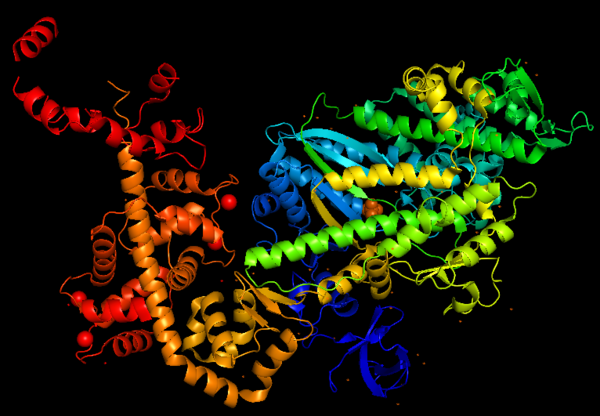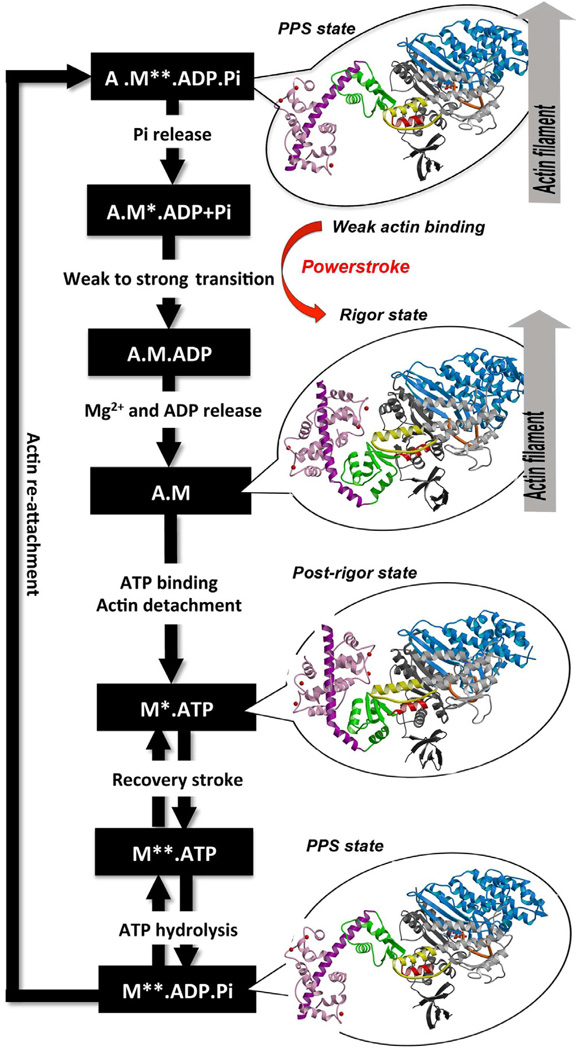User:Marcos Vinícius Caetano/Sandbox 1
From Proteopedia
(Difference between revisions)
| Line 3: | Line 3: | ||
== Introduction == | == Introduction == | ||
| - | Myosin consists of a superfamily of '''actin motor protein''', being composed of at least 20 structurally and functionally distinct classes. Specifically in humans, there are 39 myosin genes, encoding 12 of these classes. Myosins use ATP hydrolysis to move molecular cargoes along the actin filaments inside the cell. To this day, all characterized myosins move toward the plus-end of the filaments, except for '''myosin VI''', which moves in the opposite direction. | + | Myosin consists of a superfamily of '''actin motor protein''', being composed of at least 20 structurally and functionally distinct classes. Specifically in humans, there are 39 myosin genes, encoding 12 of these classes. Myosins use ATP hydrolysis to move molecular cargoes along the actin filaments inside the cell. To this day, all characterized myosins move toward the plus-end of the filaments, except for '''myosin VI''', which moves in the opposite direction. <ref>Krendel, M., & Mooseker, M. S. (2005). Myosins: tails (and heads) of functional diversity. Physiology (Bethesda, Md.), 20, 239–251. https://doi.org/10.1152/physiol.00014.2005</ref> '''Myosin VI''' is the only myosin that moves towards the '''minus-end of the actin filament''' and this unique property was the target of different studies throughout the years, and it is studied until nowadays, showing the versatility and importance of this protein. |
| - | '''Myosin VI''' is the only myosin that moves towards the '''minus-end of the actin filament''' and this unique property was the target of different studies throughout the years, and it is studied until nowadays, showing the versatility and importance of this protein. | + | |
[[Image:MyoVI.png|600px]] | [[Image:MyoVI.png|600px]] | ||
| Line 10: | Line 9: | ||
| - | The '''basic structure''' of myosin VI, and most myosin molecule heavy chains, consists of '''three regions''': | + | The '''basic structure''' of myosin VI, and most myosin molecule heavy chains, consists of '''three regions''' <ref>Magistrati, E., & Polo, S. (2021). Myomics: myosin VI structural and functional plasticity. Current opinion in structural biology, 67, 33–40. https://doi.org/10.1016/j.sbi.2020.09.005</ref>: |
*'''The catalytic motor head domain''' (N-terminal motor): responsible for binding to actin and hydrolysis of ATP. It is a highly conserved structure; | *'''The catalytic motor head domain''' (N-terminal motor): responsible for binding to actin and hydrolysis of ATP. It is a highly conserved structure; | ||
*'''The neck region''': contains the IQ domain/motif that bind light chains (calcium sensor calmodulin); | *'''The neck region''': contains the IQ domain/motif that bind light chains (calcium sensor calmodulin); | ||
| Line 19: | Line 18: | ||
| - | Predicted amino acid sequences and cDNA comparison of myosin VI in different species shows '''strong evolutionary conservation''', mainly in the head/motor domain and in the distal tail region. This is probably due to the unique and different functions of this protein. This scene represents the <scene name='97/973101/Conservation/1'>Myosin VI evolutionary conservation</scene>, where <span style="color:pink">'''pink gradient'''</span> shows the more conserved region, <span style="color:grey">'''white'''</span> is average, <span style="color:blue">'''blue gradient'''</span> is the variable region and <span style="color:grey">'''grey'''</span> or <span style="color:gold">'''yellow'''</span> is insufficient data. | + | Predicted amino acid sequences and cDNA comparison of myosin VI in different species shows '''strong evolutionary conservation''', mainly in the head/motor domain and in the distal tail region <ref>Avraham, K. B., Hasson, T., Sobe, T., Balsara, B., Testa, J. R., Skvorak, A. B., Morton, C. C., Copeland, N. G., & Jenkins, N. A. (1997). Characterization of unconventional MYO6, the human homologue of the gene responsible for deafness in Snell's waltzer mice. Human molecular genetics, 6(8), 1225–1231. https://doi.org/10.1093/hmg/6.8.1225</ref>. This is probably due to the unique and different functions of this protein. This scene represents the <scene name='97/973101/Conservation/1'>Myosin VI evolutionary conservation</scene>, where <span style="color:pink">'''pink gradient'''</span> shows the more conserved region, <span style="color:grey">'''white'''</span> is average, <span style="color:blue">'''blue gradient'''</span> is the variable region and <span style="color:grey">'''grey'''</span> or <span style="color:gold">'''yellow'''</span> is insufficient data. |
== Function == | == Function == | ||
| - | Myosins (including Myosin VI) are involved in a '''wide variety of functions''', such as cell migration and adhesion, cytokinesis, phagocytosis, maintenance of cell shape, signal transduction and intracellular transport and localization of organelles and macromolecules. Due to these diverse roles, each year more studies emerge with the objective to understand more of the structure, mechanisms and functions of myosins. | + | Myosins (including Myosin VI) are involved in a '''wide variety of functions''', such as cell migration and adhesion, cytokinesis, phagocytosis, maintenance of cell shape, signal transduction and intracellular transport and localization of organelles and macromolecules<ref>Magistrati, E., & Polo, S. (2021). Myomics: myosin VI structural and functional plasticity. Current opinion in structural biology, 67, 33–40. https://doi.org/10.1016/j.sbi.2020.09.005</ref>. Due to these diverse roles, each year more studies emerge with the objective to understand more of the structure, mechanisms and functions of myosins. |
== ATPase cycle of myosin VI== | == ATPase cycle of myosin VI== | ||
| - | Despite the fact that myosin VI directionality is reversed, it has the '''same kinetic ATPase cycle''' of interaction with actin, as shown in the figure below. There are 3 states of different conformation: Pre-powerstroke, Rigor state and Post-rigor state. | + | Despite the fact that myosin VI directionality is reversed, it has the '''same kinetic ATPase cycle''' of interaction with actin, as shown in the figure below. There are 3 states of different conformation: Pre-powerstroke, Rigor state and Post-rigor state <ref>Ménétrey, J., Isabet, T., Ropars, V., Mukherjea, M., Pylypenko, O., Liu, X., Perez, J., Vachette, P., Sweeney, H. L., & Houdusse, A. M. (2012). Processive steps in the reverse direction require uncoupling of the lead head lever arm of myosin VI. Molecular cell, 48(1), 75–86. https://doi.org/10.1016/j.molcel.2012.07.034</ref>. |
[[Image:States of myosin.jpg|600px]] | [[Image:States of myosin.jpg|600px]] | ||
| Line 87: | Line 86: | ||
== References == | == References == | ||
| + | <references /> | ||
| - | *Magistrati, E., & Polo, S. (2021). Myomics: myosin VI structural and functional plasticity. Current opinion in structural biology, 67, 33–40. https://doi.org/10.1016/j.sbi.2020.09.005 | ||
| - | |||
| - | *Krendel, M., & Mooseker, M. S. (2005). Myosins: tails (and heads) of functional diversity. Physiology (Bethesda, Md.), 20, 239–251. https://doi.org/10.1152/physiol.00014.2005 | ||
| - | |||
| - | *Avraham, K. B., Hasson, T., Sobe, T., Balsara, B., Testa, J. R., Skvorak, A. B., Morton, C. C., Copeland, N. G., & Jenkins, N. A. (1997). Characterization of unconventional MYO6, the human homologue of the gene responsible for deafness in Snell's waltzer mice. Human molecular genetics, 6(8), 1225–1231. https://doi.org/10.1093/hmg/6.8.1225 | ||
| - | |||
| - | *Ménétrey, J., Isabet, T., Ropars, V., Mukherjea, M., Pylypenko, O., Liu, X., Perez, J., Vachette, P., Sweeney, H. L., & Houdusse, A. M. (2012). Processive steps in the reverse direction require uncoupling of the lead head lever arm of myosin VI. Molecular cell, 48(1), 75–86. https://doi.org/10.1016/j.molcel.2012.07.034 | ||
*Ménétrey, J., Llinas, P., Cicolari, J., Squires, G., Liu, X., Li, A., Sweeney, H. L., & Houdusse, A. (2008). The post-rigor structure of myosin VI and implications for the recovery stroke. The EMBO journal, 27(1), 244–252. https://doi.org/10.1038/sj.emboj.7601937 | *Ménétrey, J., Llinas, P., Cicolari, J., Squires, G., Liu, X., Li, A., Sweeney, H. L., & Houdusse, A. (2008). The post-rigor structure of myosin VI and implications for the recovery stroke. The EMBO journal, 27(1), 244–252. https://doi.org/10.1038/sj.emboj.7601937 | ||
Revision as of 19:16, 14 July 2023
Myosin VI nucleotide-free (MDinsert2-IQ) crystal structure
| |||||||||||




